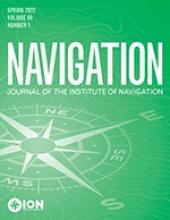Research ArticleRegular Papers
Open Access
A Station-Specific Ionospheric Modeling Method for the Estimation and Analysis of BeiDou-3 Differential Code Bias Parameters
Ningbo Wang, Zishen Li, Andrzej Krankowski, and Xingliang Huo
NAVIGATION: Journal of the Institute of Navigation March 2022, 69 (1) navi.509; DOI: https://doi.org/10.33012/navi.509
Ningbo Wang
1Aerospace Information Research Institute (AIR), Chinese Academy of Sciences (CAS), Beijing 100094, China
Zishen Li
1Aerospace Information Research Institute (AIR), Chinese Academy of Sciences (CAS), Beijing 100094, China
Andrzej Krankowski,
2Space Radio-Diagnostics Research Centre, University of Warmia and Mazury in Olsztyn, 10-720 Olsztyn, Poland
Xingliang Huo
3State Key Laboratory of Geodesy and Earth’s Dynamics, Innovation Academy of Precision Measurement Science and Technology (APM), CAS, Wuhan 430077, China

REFERENCES
- ↵
- Gong, X.,
- Lou, Y.,
- Zheng, F.,
- Gu, S.,
- Shi, C.,
- Liu, J., &
- Jing, G.
- ↵
- Hauschild, A., &
- Montenbruck, O.
- ↵
- Hernández-Pajares, M.,
- Juan, J. M., &
- Sanz, J.
- Hernández-Pajares, M.,
- Roma-Dollase, D.,
- Krankowski, A.,
- García-Rigo, A., &
- Orús-Pérez, R.
- ↵
- Juan, J. M.,
- Rius, A.,
- Hernández-Pajares, M., &
- Sanz, J.
- ↵
- Li, Z.,
- Yuan, Y.,
- Li, H.,
- Ou, J., &
- Huo, X.
- ↵
- Li, Z.,
- Yuan, Y.,
- Fan, L.,
- Huo, X., &
- Hsu, H.
- ↵
- Li, Z.,
- Wang, N.,
- Liu, A.,
- Yuan, Y.,
- Wang, L.,
- Hernández-Pajares, M.,
- Krankowski, A., &
- Yuan, H.
- ↵
- Liu, T.,
- Zhang, B.,
- Yuan, Y.,
- Li, Z., &
- Wang, N.
- ↵
- Montenbruck, O.,
- Hauschild, A.,
- Steigenberger, P.,
- Hugentobler, U.,
- Teunissen, P., &
- Nakamura, S.
- ↵
- Montenbruck, O.,
- Hauschild, A., &
- Steigenberger, P.
- ↵
- Sanz, J.,
- Juan, J. M.,
- Rovira-Garcia, A., &
- González-Casado, G.
- ↵
- Sardón, E.,
- Rius, A., &
- Zarraoa, N.
- ↵
- Shu, B.,
- Liu, H.,
- Xu, L.,
- Gong, X.,
- Qian, C.,
- Zhang, M., &
- Zhang, R.
- ↵
- Tang, C.,
- Hu, X.,
- Zhou, S.,
- Liu, L.,
- Pan, J.,
- Chen, L.,
- Guo, R.,
- Zhu, L.,
- Hu, G.,
- Li, X.,
- He, F., &
- Chang, Z.
- ↵
- Themens, D. R.,
- Jayachandran, P. T., &
- Langley, R. B.
- ↵
- Vergados, P.,
- Komjathy, A.,
- Runge, T. F.,
- Butala, M. D., &
- Mannucci, A. J.
- ↵
- Wang, N.,
- Yuan, Y.,
- Li, Z.,
- Montenbruck, O., &
- Tan, B.
- ↵
- Wang, N.,
- Yuan, Y.,
- Li, Z.,
- Li, Y.,
- Huo, X., &
- Li, M.
- ↵
- Wang, N.,
- Li, Z.,
- Montenbruck, O., &
- Tang, C.
- ↵
- Wang, N.,
- Li, Z.,
- Duan, B.,
- Hugentobler, U., &
- Wang, L.
- ↵
- Wanninger, L., &
- Beer, S.
- ↵
- Wu, Z.,
- Zhou, S.,
- Hu, X.,
- Liu, L.,
- Shuai, T.,
- Xie, Y.,
- Tang, C.,
- Pan, J.,
- Zhu, L., &
- Chang, Z.
- ↵
- Xiao, W.,
- Liu, W., &
- Sun, G.
- ↵
- Yang, Y.,
- Li, J.,
- Wang, A.,
- Xu, J.,
- He, H.,
- Guo, H.,
- Shen, J., &
- Dai, X.
- ↵
- Yang, Y.,
- Xu, Y.,
- Li, J., &
- Yang, C.
- ↵
- Yang, Y.,
- Mao, Y., &
- Sun, B.
- ↵
- Yuan, Y., &
- Ou, J.
- ↵
- Zhang, B.,
- Ou, J.,
- Yuan, Y., &
- Li, Z.
- ↵
- Zhang, B.,
- Teunissen, P. J. G.,
- Yuan, Y.,
- Zhang, X., &
- Li, M.
- ↵
- Zhou, R.,
- Hu, Z.,
- Zhao, Q.,
- Li, P.,
- Wang, W.,
- He, C.,
- Cai, C., &
- Pan, Z.
In this issue
NAVIGATION: Journal of the Institute of Navigation
Vol. 69, Issue 1
Spring 2022
A Station-Specific Ionospheric Modeling Method for the Estimation and Analysis of BeiDou-3 Differential Code Bias Parameters
Ningbo Wang, Zishen Li, Andrzej Krankowski,, Xingliang Huo
NAVIGATION: Journal of the Institute of Navigation Mar 2022, 69 (1) navi.509; DOI: 10.33012/navi.509
Jump to section
Related Articles
Cited By...
- No citing articles found.






